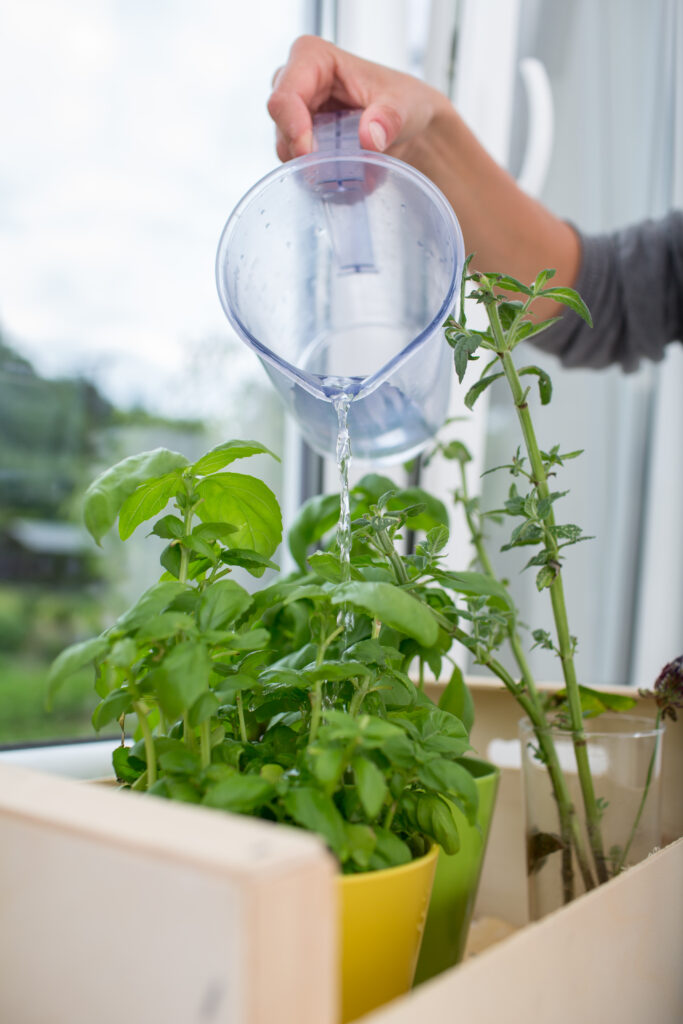How to Grow Herbs in Containers
Do you struggle with enough space to garden? No worries! Today I will share with you how to grow herbs in pots and other containers so you can enjoy the goodness of fresh-cut seasonings all year long.
Gardening 101 includes herbs and knowing how to grow them successfully right outside your kitchen door.
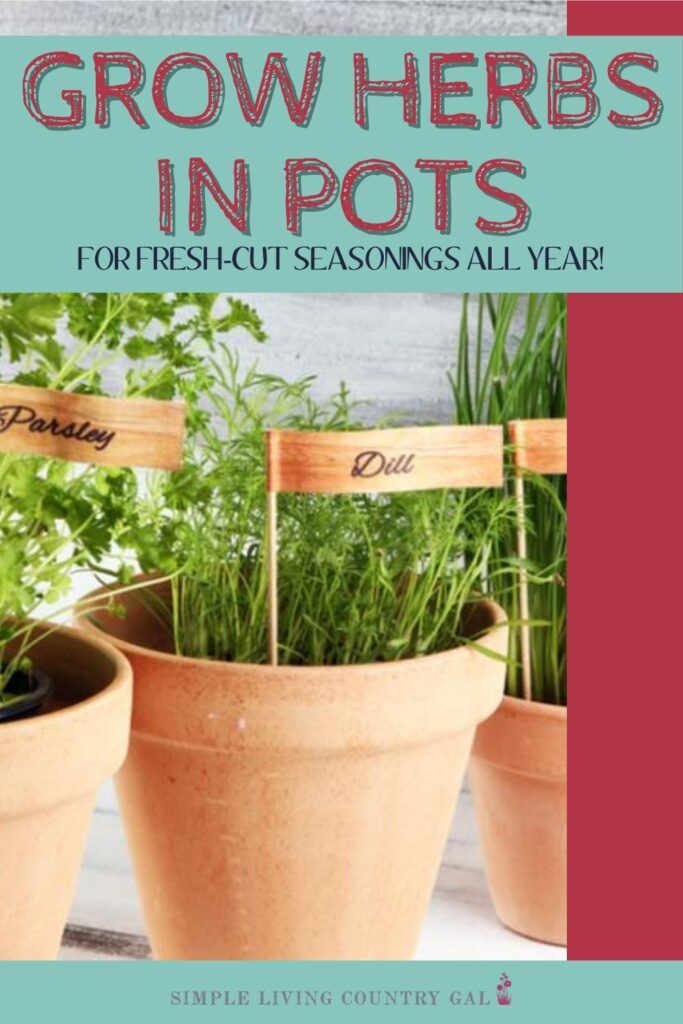
If you enjoy cooking meals loaded with flavor, you probably use a lot of fresh herbs. Yes, you can find fresh herb cuttings in the grocery store now, but those snippets can be expensive and how do you know if the flavor is still there?
When I first started gardening, herbs were one of those plants that was easy for me to grow. They are what I like to call self-sufficient plants, and they can help you to try out growing your own food.
Growing fresh herbs can save money and provide you with an unlimited supply of the most amazing selection of herbs, especially those you use most often.
No matter where you live, you can fit an herb garden into your setup. Herbs not only do well in containers, they thrive in them and that means you can get started growing a few plants today.
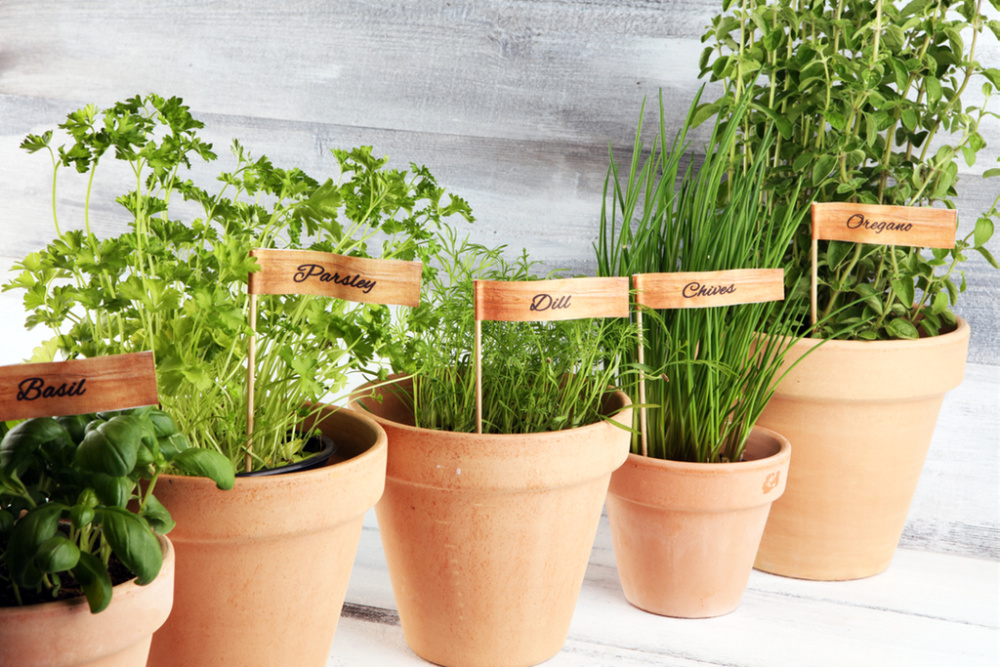
I have grown herbs for many years now, and I have tried just about every setup, container, and location, and I have yet to find a way that doesn’t work. If you have soil, sunshine, and water you can get started growing an herb garden.
How to Grow Herbs in Pots
Growing herbs in pots and containers is incredibly convenient. With so many options on the market today, you can easily find a way to grow your herbs in the space you have available. From flower pots to hanging bags, if you don’t have an option at home you can purchase one instead.
Planning Your Herb Container Garden
I am a planner and nowhere is this more helpful than when growing plants. Planning ahead will not only save you time but it will also ensure the very best results with your herb garden year over year.
It’s important to know that not all plants are created equal. Some want to be near other plants, while others want to be grown alone. Knowing the likes of each will help you to better choose the best location for your plants. This is called companion planting, and you will find it helpful to know before you begin.
What is companion planting?
Companion planting is planting certain plants near each other to encourage better growth. Marigolds, for example, will deter hornworm caterpillars when planted near tomato and pepper plants.
Companion planting will also help you to keep certain plants from others. For example, if you plant Fennel next to Basil, as the Fennel grows, it will block out the sun, affecting the growth of the Basil.
You can use our herb companion planting chart to determine which plants are your plant’s friends and which ones you want to avoid.
What herbs should you grow in an herb garden?
When planning your herb container garden, consider the herbs you use most in your kitchen. The most common herbs include rosemary, parsley, thyme, oregano, basil, mint, and dill. But you may not use these herbs frequently enough to want to grow them all.
In our home, basil is a staple. There is nothing quite as wonderful as fresh basil and having a supply right there on my window sill whenever I need it allows me to up the flavor of so many of my dishes.
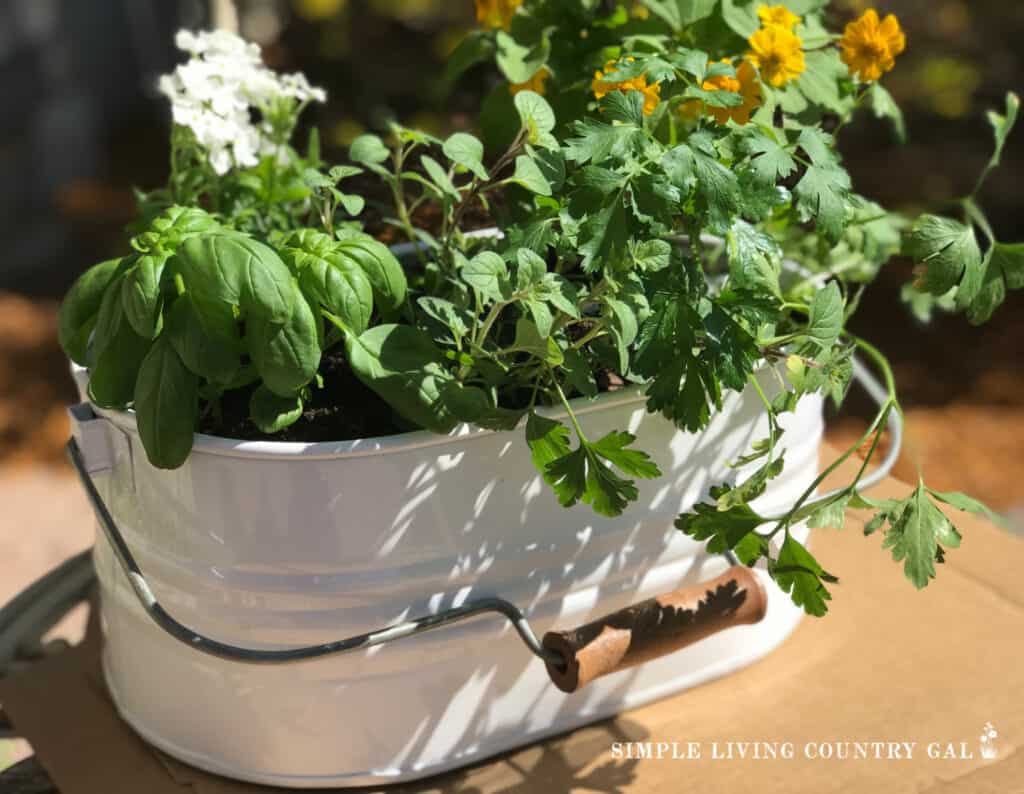
Start with the herbs you use the most; you can always expand your garden if you find you have the space. When I started my first herb garden, I chose four of my favorites and expanded from there.
SLCG PRO TIP: When gardening, the trick to not getting overwhelmed is to start out small. Pick a few of your favorites and give them a try. With only a few, you will be more easily able to keep up with watering, trimming, and even using the herbs that you grow.
Choosing the Right Pots for Your Herb Garden
There are a few things to consider when choose a container for your herb plants.
#1. Drainage
The most important part of choosing pots is to ensure enough drainage. Having holes at the bottom will keep excess water from gathering where the roots of the plant are.
The roots are where the magic happens, and setting things up to ensure they are healthy is the secret to a large, full, and vibrant herb plant. Too much water may do more harm than good and can rot the root system, giving you a lackluster and small herb plant.
#2. Room to Grow
Most herbs don’t have an extensive root system, which means a smaller pot will work for most plants. However, using a smaller container also means less soil, and that can bring the risk of over or under-watering.
You can use a self-watering container to help regulate how much water your plant is getting.
Gardening Resources:
How to Grow Herbs in Pots
There are a few things to mention when growing herbs; let’s go over each to help you better set up an environment your plants thrive in.
Sun
Herbs need a significant amount of sun, preferably about 8-10 hours a day, to grow. Yes, location really does matter in this instance, but the beauty of growing herbs in containers is the ability to move them around as needed.
You will need to watch to know how much sun an area receives daily. Set an alarm on your phone to remind you to check the location every hour or so to ensure the sun is hitting the spot you are considering.
Soil
It is important to use a high-quality potting mix for herbs that will encourage more vibrant growth. You can purchase a moisture control potting soil if you are concerned about watering correctly.
Temperature
Heat is another factor to consider. Temperatures that are too hot can dry your herbs and cause them to need more moisture. If you live in a hot climate, you may need to consider growing your herbs either indoors or in a protected area outside.
You can use this soil meter to measure soil pH, moisture levels, and temperatures.
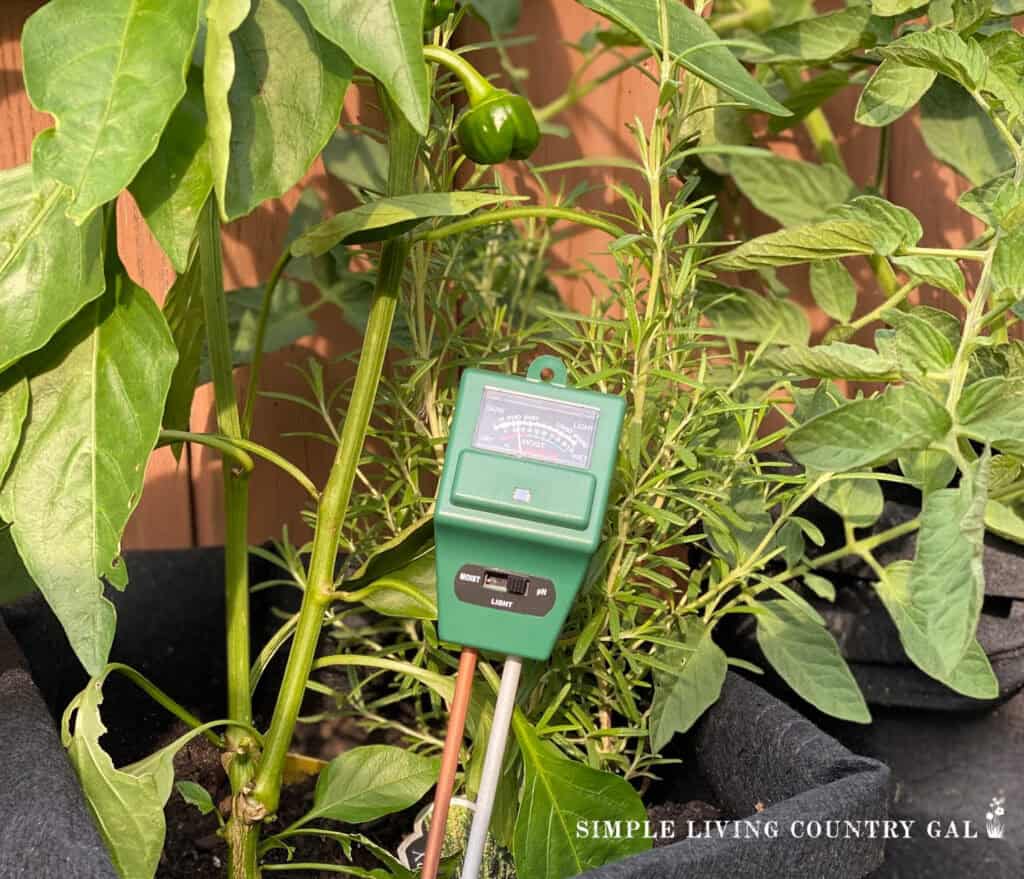
Fertilizer
Herb gardens don’t need a lot of fertilizer, and over-fertilizing can kill them. Some herbs will also lose their flavor if they’re over-fertilized. A few drops of plant food added to the water every couple of weeks is enough to provide nutrients without overfeeding.
Best Herbs for Container Gardening
Let’s look at some of the best options for growing in containers and an overview of each. This will help you to make a list of herbs you want to start out with in your new container garden.
• Basil – Basil is one of the most common herbs to grow. Not only is it great on pasta and in sauces, but it also provides a nice flavor for salads. It prefers full sunlight and moist soil and needs fertilizing.
It will take about six weeks for the root system to become established, but after that, it can tolerate short periods of dryness. There are several varieties, some growing as tall as two feet.

• Cilantro – Also known as coriander, it’s most commonly used for its leaves, but don’t discount its dried ground seeds. It likes a good drainage system for its soil and lots of sunlight.
Cilantro grows a long root system so it will need a container that’s at least 12 inches deep. Depending on the variety, it can grow up to 2 feet tall.
• Chives – Chives are essentially tiny onions grown for their leaves and blooms. They are grassy, clump-forming perennials, have hollow leaves, and their pink-purple flowers are edible.
They prefer nutrient-rich soil and a pot with good drainage. They grow best in full sunlight but can tolerate a little shade. They can grow as tall as 18-20 inches.
• Lavender – Lavender is very fragrant and makes a nice addition to cookies and cakes, but it also grows beautiful flowers that brighten up your home. The scent is also known for its calming abilities, so it’s perfect for making scented candles or oils to encourage relaxation.
It’s a bushy shrub, so it usually doesn’t like to share a pot with anything else. It needs full sunlight and good drainage; it prefers to stay dry and doesn’t like fertilizer. It can grow as tall as two feet.
• Tarragon – This classic French herb is most commonly used to season fish and has a bold flavor. Tarragon needs good drainage, like a few days of dry soil between waterings, and prefers lots of sun. It can grow as tall as three feet high.
• Lemon Balm – Lemon balm spreads quickly, so it does better in a container than in your yard to keep it under control. It likes partial shade to full sun, and it likes its soil to stay moist, but well-drained. It can grow up to two feet tall.
• Lemon Verbena – With its lovely scent and flavor, lemon verbena is perfect for scented candles and tea, as well as some baked goods and chicken. It’s a tropical shrub and likes a container of well-drained potting soil and no fertilizer. In full sunlight, it can grow up to three feet high.
• Parsley – Whether you use it for cooking or to pretty up your dinner plate, parsley is a popular herb. When planting, remember that it likes regular water and feeding, so a self-watering pot and slow-release fertilizer at planting time can keep this herb happy. It likes the sun, but it can tolerate partial shade.
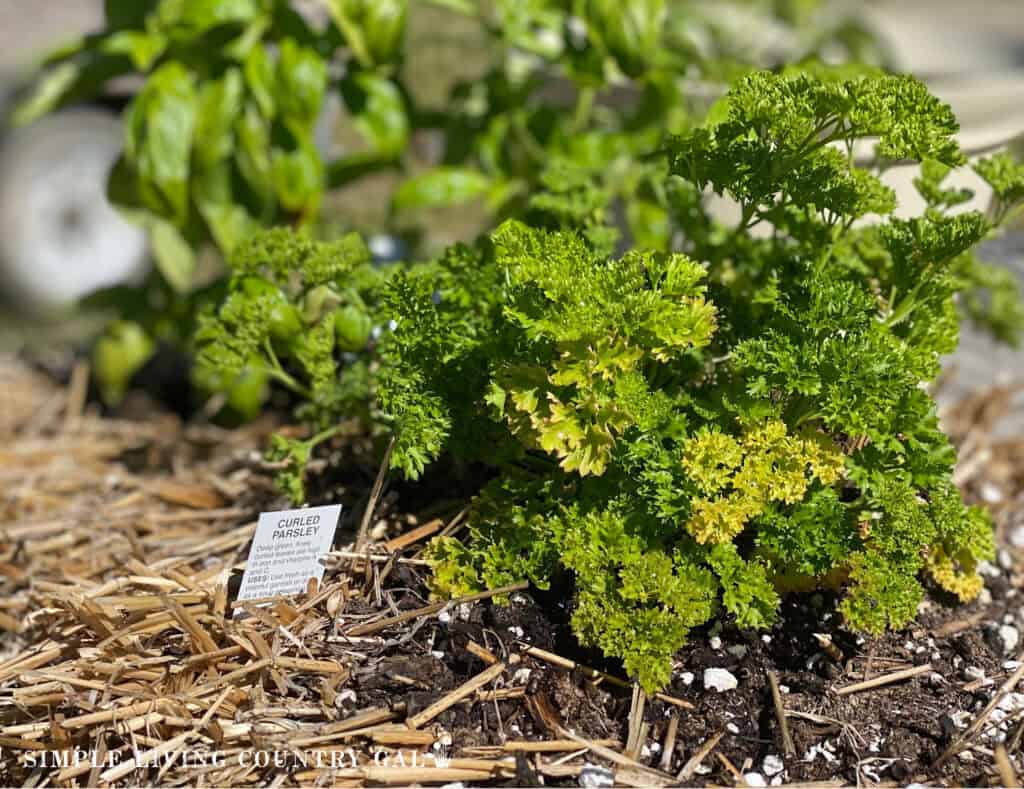
• Mint – Mint is another herb that can be used for so many things. It’s great for baked goods, flavoring whipped cream, or brewing for tea. Its lovely scent is invigorating so it’s a wonderful addition to lotions and candles.
Grown in the ground, it can become invasive, so growing this herb in a pot is best. Like many herbs, it prefers full sun but can tolerate partial shade. It’s hearty and can grow in various soil types, but it produces the best leaves in nutrient-rich soil. There are several varieties, and their size varies, but they can grow up to two feet tall.
• Oregano – Oregano is essential to any Mediterranean cuisine. It doesn’t do well in wet soil, so proper drainage is necessary. Also, full sunlight is best; the more sun it gets, the stronger the flavor. Oregano will grow about two feet tall.
• Marjoram – Marjoram is similar to oregano, but a little sweeter and milder in flavor, and it’s more aromatic. It prefers full sunlight and well-drained potting soil, and it can grow as high as two feet. It’s a perennial, so it will still thrive in the winter indoors.
• Rosemary – Rosemary is another essential herb in Mediterranean cooking. And the fragrant smell will give your kitchen a lovely scent, making it a good addition to scented candles. It can grow up to three feet tall and need quick-draining soil to thrive.
Keep the soil moist but never wet when growing indoors. It prefers hot, dry, and sunny areas.
• Thyme – Thyme comes in many varieties, and they all grow well in full sunlight with well-drained soil. Thyme doesn’t like wet soil, so don’t overwater and let it dry out for a few days between watering. It only grows about 10 inches tall making it a perfect option for smaller containers.
• Sage – Sage is great for seasoning poultry as well as adding to a variety of teas. It likes lots of sun and moist but well-drained soil. It can grow up to two feet high.
GREAT TOOLS FOR PRESERVING HERBS
PROTITOUS 2pack Herb Drying Rack with 20pcs Golden Herb Dryer Hooks and 25PCS Brown Gift Tags and 32ft Natural Jute Twine herb Dryer,herb Dryer,herb Drying Rack,Hanging Herb Dryer Rack


Best Herbs to Plant Together
Many herbs do well when planted together, especially ones that require the same amount of light and the same type of soil.
Most Mediterranean herbs will support each other’s growth and even give each other a better flavor.
Some favorites to plant together include:
- Sage
- Thyme
- Rosemary
- Oregano
- Marjoram
- Lavender
Other herbs that tend to do well together are:
- Tarragon
- Cilantro
- Basil
- Parsley
They all love moisture so they’ll thrive together. Although parsley is a biennial and will die after about 2 years so it will need to be removed from the grouping.
Herb Growing Guide
To successfully grow herbs in pots, there are a few things you’ll need to consider before and after planting.
Find Sun – Almost all herbs are sun lovers and require a minimum of 6 hours a day of direct sunlight, some more, although in warmer regions, they do like to get some afternoon shade to cool off.
Choose the Right Containers – Your container needs to be large enough to hold the herb’s root system. To find the right size, choose a pot that’s at least 1/3 the height of the expected size of the plant. For instance, a plant that can grow up to 2 feet tall will need a pot at least 8 inches deep.
Check the plant’s height on the plant tag or seed packet. For plants that grow larger, like lemon balm and lavender, larger is definitely better when it comes to both depth and circumference. Regardless of which type of pot you choose, all of your herbs will require drainage holes.
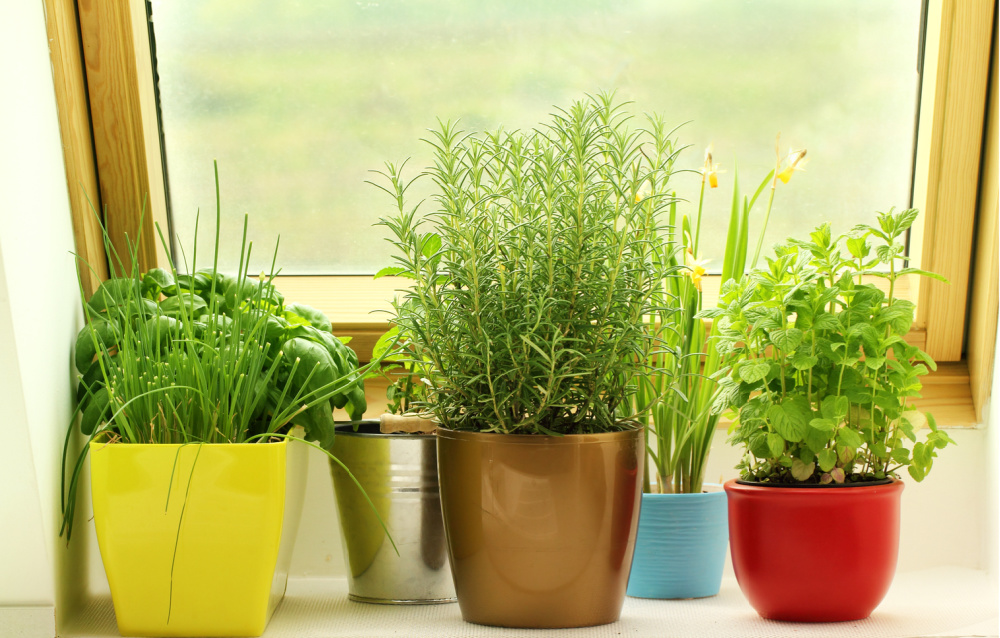
Choose Good Soil – Your herbs will require nutrient-rich soil to thrive so choose a good quality potting soil, preferable one that provides moisture control to prevent against over and under watering.
Potting soil is better than garden soil for your container herb garden. It’s not as dense as garden soil so it allows more water and air to circulate around the root system. If you keep your garden growing instead of replanting every year, you’ll want to add a soil revitalizer over the existing soil about once a year to renew the soil’s natural nutrients.
Water According to Needs – While some plants prefer to go dry between waterings, others prefer to have their soil constantly moist. Read the watering instructions on the plant tag or seed packet to ensure your giving your herbs the proper amount of water without drowning them.
- Herbs that need consistent water: Parsley, marjoram, mint, and chives.
- Herbs that require less moisture: Oregano, thyme, rosemary, and basil.
Harvesting Fresh Herbs from Pots
As you can see by the herb guide above, most can grow very tall. Proper harvesting will not only ensure continued health and growth, it will also help to keeps your herb plants under control.
Pick leaves often to encourage new growth, but don’t over-harvest. Never harvest more than 1/4 of the herb at a time. For herbs with leaves that grow in clumps, harvest the outer leaves first, working your way in to the center. For herbs that have an upright stem, you can simply snip off individual branches.
Hydroponic Herb Gardens
In addition to a container herb garden, there is another way to grow herbs; hydroponically. A hydroponic herb garden allows you to grow herbs in water instead of soil; the root system grows directly in water.
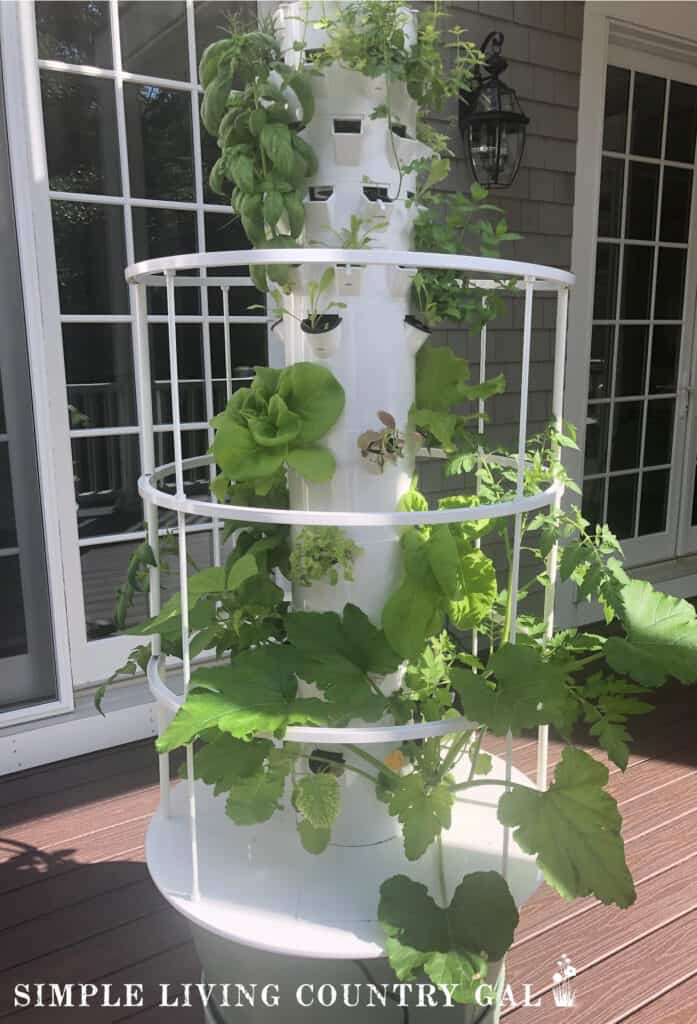
This kind of garden can take up more space and it does require special equipment so you’ll need to keep that in mind. For starters, it’s best grown indoor with grow lights so you’ll need to purchase those and create a space with a table to set up your garden.
In addition to lights, you’ll need a variety of other equipment like growing containers that can hold water, grow cubes, distilled water, pH testing kit, and an air pump to circulate the water.
It can be more challenging to manage than a container garden, but it will give you healthy herb plants in about 2 months’ time.
Now that you know how to grow herbs in pots, what are you waiting for? You can easily plan, organize, and plant your garden over a weekend and start cooking with fresh herbs sooner than you’d think. You’ll have so many fresh and tasty herbs you’ll want to find new ways to use them every day.

